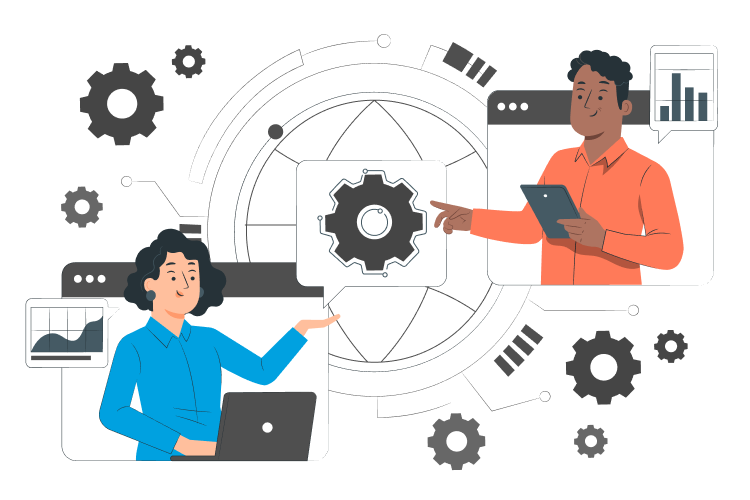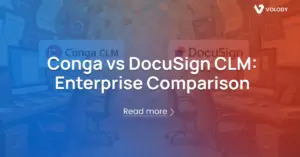In the business world that moves fast, companies are always on the lookout to improve things and work more smoothly. They often don’t pay enough attention to how they handle contracts. Contracts are super important because they lay out the rules for working with suppliers, customers, and your team members. If you manage these contracts well, you can save money, follow regulations more easily, and avoid problems.
For people in charge of technology in a company (IT leaders), it’s especially important to understand something called Contract Lifecycle Management (CLM). It is all about taking care of an organization’s contracts from when they start until when they end or need to be renewed. This includes using special software that helps automate everything about managing contracts so mistakes are less likely and everything runs smoother.
These IT bosses have a big job making sure this contract management software fits nicely into what their company already uses for its tech stuff like ERP systems which help run financials or CRM tools used by sales teams.
By picking out the right kind of software and following some smart steps during setup while also making sure it works well with other programs companies use every day; organizations can not only cut costs but also keep things running without hiccups.
Understanding Contract Lifecycle Management

Contract Lifecycle Management is about managing a company’s contracts from start to finish. This includes starting contracts, making sure they run smoothly, and deciding whether to renew or end them. CLM relies on special software to make this process easier and more efficient. With this software, companies can work faster, make fewer mistakes, and easily follow legal rules.
By moving contract management online and automating it, businesses can eliminate paperwork, speed up their workflow, and keep better track of important contract details. This software acts as a central place where everyone involved can find information about any agreement at any time. It also makes it easy to monitor how well each contract is doing, ensuring compliance.
As we embrace digital transformation and managing contracts becomes more complex, the importance of CLM has increased. It has become essential for organizations to reduce clutter, get the most out of their deals, and simplify contract management.
Significance of CLM in Business Operations
Contract Lifecycle Management is all about how a company handles its contracts from start to finish. This includes when contracts are first created, while they are active, and what happens when they need to end or be renewed. It uses special software to manage contracts, making the process more efficient, saving money, and ensuring everyone follows the rules.
Contracts are essential to every business because they outline what each party has agreed to do. They cover deals with suppliers, customers, and even employees, setting out expectations and responsibilities. Managing these agreements well with CLM practices, from drafting terms to making renewal or termination decisions, ensures everything runs smoothly.
By using CLM strategies and contract management software, companies can reduce repetitive manual work and speed up processes. This leads to greater efficiency and lowers the risk of errors and non-compliance. These systems provide an easy way to keep track of important documents and ensure that milestones and legal standards are met.
In short, having a good system in place to manage contracts effectively is invaluable for companies. It helps optimize processes, minimize risks, and maximize benefits, ensuring long-term success and sustainability.
Related Article: Elevate Technology Industry With Contract Management Software
The Role of IT Leaders in CLM Integration

In the world of IT, leaders have a big job when it comes to fitting Contract Lifecycle Management into an organization’s tech setup. Their main task is to make sure that legal steps and IT systems work together smoothly so that the software can be used without any hitches.
These leaders team up with legal groups to get a clear picture of what they need and use their know-how in tech to pick and set up the best CLM platform. They also work hand in hand with folks from procurement and finance departments, making sure everything meshes well with the systems already in place.
On top of all this, IT chiefs must keep an eye on important stuff like keeping data safe, making sure the system can grow as needed, and ensuring everyone finds it easy to use. With their deep understanding of technology, these leaders are key players in bringing successful CLM integration alive. This helps organizations get the most out of managing their contracts efficiently.
Bridging the Gap Between Legal Processes and IT Infrastructure
In the world of contract management, IT leaders play a crucial role in making sure that legal teams and tech systems work together smoothly. They do this by really getting what legal folks need and using their tech smarts to pick and set up the best contract management software for the job.
With an eye on easing contract lifecycle headaches, IT chiefs team up with lawyers to pinpoint exactly what bugs them about managing contracts. Together, they figure out which bells and whistles in a CLM platform will make everyone’s life easier.
On top of all that, these IT gurus have to ensure that the new system fits perfectly with other tools already in use like ERP and CRM. This means they’ve got to be super familiar with how all the organization’s tech bits connect while also playing nice with departments such as procurement and finance during setup.
Related Article: 3 Effective Contract Management Strategies: Dos And Don’ts
IT Teams: What to Look For in a CLM?

- Integration capabilities: It’s crucial that the tool can easily work together with other systems you already use like CRM, ERP, and procurement tools. This helps make everything run smoother and keeps data flowing properly.
- Customization options: You’ll want to find CLM software that lets you tweak things so they fit just right with what your organization needs and how it does things.
- Scalability: Think about whether the CLM solution can grow as your company does, handling more contracts without missing a beat.
- User-friendly interface: Choose the software that’s easy for people to use right off the bat. This makes it easier for everyone to get on board without needing lots of training.
- Procurement management: Make sure the CLM solution has strong features for managing procurement well. This means making sure contracts can be created, approved, and carried out smoothly.
Related Article: Preparing For Successful CLM Implementation: Are You Ready?
Benefits of CLM for Organizational Efficiency

By putting Contract Lifecycle Management solutions to work, organizations can see a big boost in how efficiently they operate. With CLM software, the whole process of handling contracts gets automated. This change cuts down on both time and money spent.
It does away with the need for doing things by hand, makes everything quicker from start to finish, and lets you keep a better eye on all your contract details. On top of that, this software helps make sure companies stick to their agreements and meet any legal standards required of them. By moving contract processes online and automating them, businesses not only become more efficient but also cut down on mistakes and step up their game overall.
Streamlining Contract Processes Through Automation
CLM makes handling contracts a lot easier by using automation. With the software, the usual steps like making, checking, and okaying contracts are done automatically. This cuts down on having to do things by hand. Not only does this save time, but it also means fewer mistakes and better accuracy.
With automation in place, companies can make sure their contract templates and what’s in them stay the same across all documents. This keeps everything consistent and follows contracting rules without having to enter the same information over and over again manually.
On top of that, CLM software comes with workflow features that let businesses set up how they want their contract approval process to work automatically. This smooths out the whole lifecycle of a contract from start to finish which speeds things up and boosts how well operations run overall.
So basically, automating contract processes with this software helps organizations work more efficiently while cutting costs down too – not forgetting to stay right within legal boundaries.
Enhancing Compliance and Minimizing Risks with CLM
CLM is important for keeping things in line and safe for companies. With this software, companies can make sure everyone sticks to their promises by enforcing the rules of contracts. This software keeps all contract stuff in one place, so it’s easier to keep an eye on everything and make sure no one’s breaking the rules.
On top of that, this kind of software takes care of private info well. It controls who can see what and keeps a watchful eye on who does what with the data, which helps stop any sneaky peeks or leaks.
By making contract tasks automatic and working smoothly with other company systems, CLM software makes everything clear as day. This means companies can spot problems early before they turn into bigger headaches.
Related Article: Legal Playbook: Essential Reasons Why Your Business Needs One
Overcoming Challenges in CLM Adoption

When companies decide to use CLM solutions, they often run into a few roadblocks. One big issue is that people within the organization might not be too keen on changing how things are done. They’re used to their old ways and might need extra help and training to get comfortable with the new CLM system.
On top of this, there are technical challenges as well. These can include problems getting the CLM solution to work well with current IT setups, worries about whether it can handle growing needs over time, and difficulties in moving existing data into the new system. IT leaders need to tackle these issues by working closely both with those selling the contract management solutions and teams inside their own company. This way, they can make sure everything goes smoothly when starting up contract management improvements.
By taking care of these obstacles properly, organizations can push past what’s holding them back from adopting CLM systems successfully. This allows them to enjoy all the perks that come with better-managing contracts throughout their lifecycle.
Addressing Common Organizational Resistance and Solutions
First, explain the benefits of CLM to everyone involved and let them have a say in the process. This makes people feel included and more open to trying something new.
Next, make sure everyone understands how the system works. Set up training sessions, provide user guides, and be available to answer questions and solve problems. This ensures that no one feels left behind.
Also, having a plan for managing these changes is crucial. Keep communication open so feedback can be shared easily, and update everyone regularly on the progress of the CLM implementation.
By focusing on clear communication, thorough training, and solid change management practices, IT leaders can tackle resistance and ensure a smooth transition to using CLM.
Technical Hurdles and How IT Can Solve Them
When setting up CLM solutions, IT leaders face some tech challenges. These include making the new system work with existing ones, ensuring it can grow with the company, and moving data without errors.
To solve integration issues, IT leaders should work closely with both the CLM system vendors and their teams. The goal is to ensure the new system works smoothly with other key business systems like ERP and CRM. This might involve creating special connections or using APIs to share data easily.
For growth concerns, it’s important to choose a CLM solution that can handle more contracts and users as the company grows. IT leaders need to check if the system can scale up before making a decision.
When moving data to the new system, it’s helpful to carefully check and clean the data beforehand. This means only useful and relevant information gets transferred securely, following privacy rules.
By addressing these technical issues from the start with careful planning and teamwork, implementing contract management becomes easier, helping businesses manage their contracts better throughout their lifecycle.
Related Article: Overcome Top 5 Contract Management Challenges With Ease
CLM Best Practices for IT Leaders

- Start by clearly figuring out what your organization needs and wants from a CLM system.
- With decisions about the system, make sure everyone involved has a say and listens to their ideas.
- Take your time checking out different CLM platforms before picking the one that fits best.
- Make a detailed plan for how you’ll put the new system in place. This should include when things will happen, who will help, and how you’ll teach people to use it.
- Work on making sure the CLM solution works well with other systems your business uses like ERP and CRM software.
- Don’t forget to train users properly and keep supporting them as they get used to it
- Regularly check how well is doing its job so you can tweak things if needed.
Integrating CLM with Existing IT Ecosystems for Maximum Benefit
To get the most out of CLM, companies need to ensure their CLM software works well with their existing IT systems. This includes systems like Customer Relationship Management (CRM), Enterprise Resource Planning (ERP), and procurement tools.
When CLM is connected with CRM tools, it provides a complete view of customer contracts. This makes managing customer relationships easier because you can see all contract details in one place. It helps businesses keep track of contract renewals, manage commitments, and improve customer satisfaction.
By linking the software with ERP systems, companies can streamline their purchasing processes. This can automate tasks like starting new contracts, getting approvals, and implementing them. Integrating these steps with purchasing helps keep finances clear and organized.
Also, when it works well with procurement systems, it becomes easier to manage suppliers. Companies can closely monitor supplier performance, ensure they follow rules, and collaborate more effectively.
Related Article: Renewing Contracts :Effective Strategies For Success
Frequently Asked Questions
What Are the First Steps IT Leaders Should Take in CLM Adoption?
- Come up with a plan for adopting CLM that matches what the organization wants to achieve.
- Work closely with legal teams to make sure everything is done right and lawyers are involved.
- Look at different CLM software choices and pick one that fits best with what the organization needs.
How Does CLM Affect Data Security and Compliance in Organizations?
Contract management software is super important when it comes to keeping data safe and making sure companies follow the rules. It puts all the contract data in one place, so only people who are supposed to see sensitive information can get to it. With CLM, companies can also keep an eye on how well they’re sticking to legal stuff and rules that they need to follow.
Conclusion
To wrap things up, managing the life of a contract, or contract management software is important for IT bosses looking to make their organizations run smoother. By making the process of handling contracts automatic and keeping everything in line with rules, CLM cuts down on risks and helps businesses do well.
To get it right, overcoming some bumps in the road means connecting legal stuff with IT systems and getting past tech problems. Sticking to best practices is crucial for tapping into all that CLM has to offer, ensuring everything goes smoothly from start to finish when putting it into action.
As this technology gets better over time, those in charge of IT need to keep an eye on new developments so they’re ready for whatever comes next. So basically, dealing with contracts through contract management software isn’t just about paperwork; it’s a big deal for boosting how well IT operations work overall.





